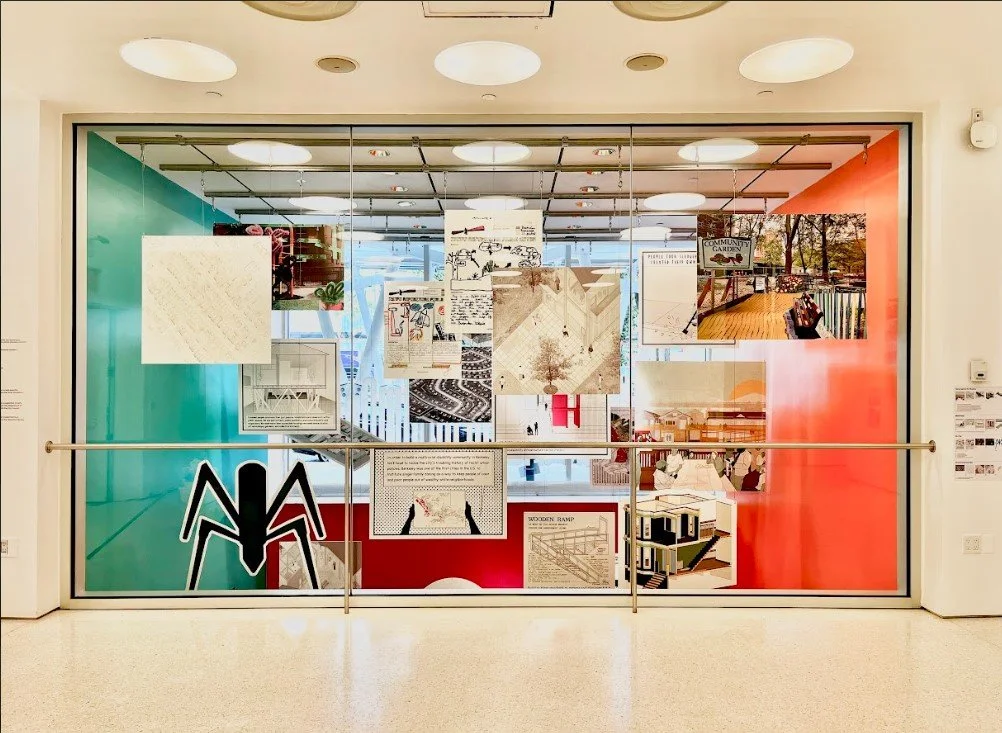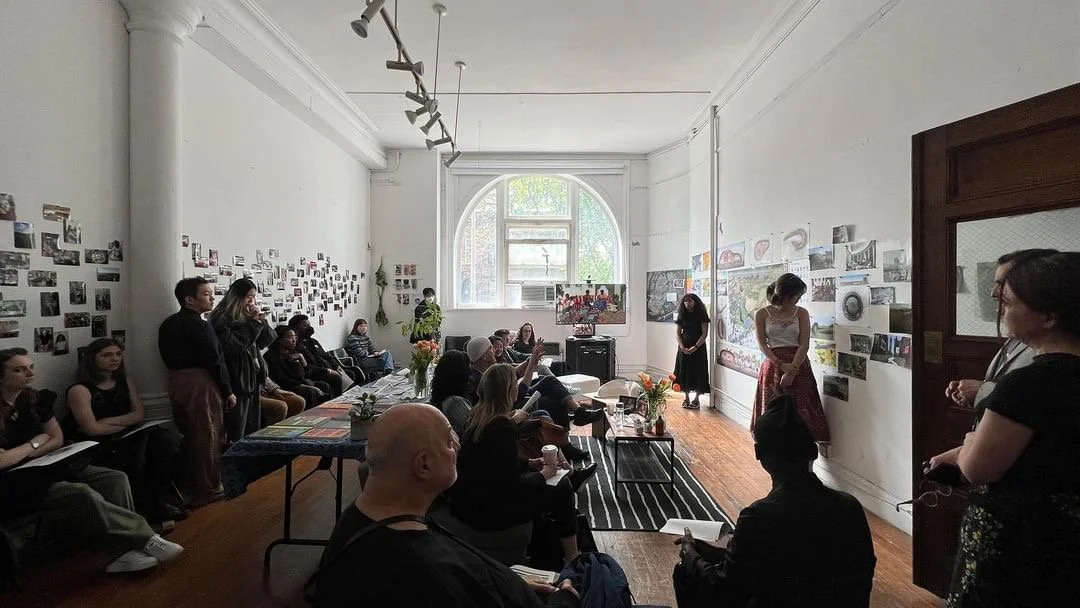Catherine Chattergoon
Architectural designer and photographer
“Architecture is a way of practicing compassion, thinking
about how we can extend care and grace towards the built environment, towards people, towards the planet.”
Version française en bas de page
〰️
Version française en bas de page 〰️
English version :
Catherine Chattergoon is an architectural designer and photographer.
Her background
Catherine was born in Brooklyn and grew up in Texas — two very contrasting environments that, from a young age, made her reflect on how spaces shape our lives. As a child, she felt a natural connection to architecture and spent hours building with Legos.
Naturally, she went on to study architecture at Pratt Institute, where she earned a Bachelor of Architecture with minors in Social Justice/Social Practice and Photography. These interdisciplinary perspectives continue to shape the way she approaches spatial design today.
Now a recent graduate, Catherine works at Adjaye Associates, an architecture firm committed to public and community-based projects. She appreciates the firm’s shared values around designing for the greater good, particularly through work on civic and cultural spaces.
Another key moment in her journey was joining NOMA (National Organization of Minority Architects), where she found a community of diverse and committed practitioners. Being part of this network was especially meaningful for her in navigating a profession that remains overwhelmingly white and male-dominated.
“there's a lot of barriers to do this work and to be in this field because of its history of being male-dominated,”.
Her vision of architecture
For Catherine, architecture is a way of practicing compassion. Drawing on Black feminist theory — especially the work of bell hooks — she approaches spatial design as an act of care and justice. Her practice is grounded in love, memory, and resistance, with co-design at its core.
“Design isn’t something done for us, but with us.”
Accessibility is another central concern for Catherine, shaped in part by personal experience. During a study abroad program in Italy, she temporarily used a wheelchair and crutches, which deepened her awareness of spatial barriers and the urgent need for truly inclusive design.
Catherine is also deeply critical of the architectural field itself. She highlights the many structural and financial barriers that continue to exclude women of color from entering and thriving in the profession. One of her hopes is to help shift this reality — particularly through teaching, a path she aspires to pursue in the future.
“Architecture is a way of practicing compassion, thinking about how we can extend care and grace towards the built environment, towards people, towards the planet.”
Projects :
When Words Become Worlds
For her final thesis project, Catherine explored what it means to care — for others, for ourselves, and for our stories — through architecture.
Inspired by the writings of bell hooks, she delved into the idea of homeplace — that intimate space where one feels safe, where healing and resistance can begin. Together with her thesis partner, Angie Widjaja, she launched a call for contributions: submit a personal photograph that captures love, tenderness, or a joyful memory.
They received over 200 images, shared by friends, classmates, professors, and even strangers moved by the project. These photographs were assembled into a wall of images — a patchwork of lives and emotions.
The project became a political gesture: making visible the stories often left out of public space. For Catherine, it was a way to root architecture in care, attention, and dignity.
Replay: Reset Toward New Commons
During a design studio at Pratt, Catherine worked with residents of a NYCHA public housing complex in East Harlem — a neighborhood shaped both by a legacy of activism and by the structural neglect of its built environment. The goal: to collectively reimagine shared living spaces, grounded in the needs and desires voiced by the residents themselves.
The central question guiding the project was: How can architecture support conviviality, intergenerational exchange, and everyday well-being?
Through storytelling and co-design workshops, the project emerged as a collaboration — a process rooted in listening, dialogue, and the lived knowledge of those who inhabit the space.
This experience marked a turning point for Catherine. It crystallized her understanding of the architect’s role as a facilitator — someone who listens deeply and supports communities in shaping their own environments.
“We need to center the people who are most impacted by the spaces we create. Their lived experience is vital to the design process.”
What’s next?
Today, Catherine is committed to continuing this socially engaged practice: earning her architecture license, learning through on-the-ground work, and developing more community-based projects. She also hopes to teach — to contribute to a more inclusive and fair profession through education and research.
More and more, she finds herself drawn to the intersection of architecture and photography — two disciplines that ask critical questions about power, representation, and visibility.
To conclude, she describes herself as a “seeker on a path” — in pursuit of joy, justice, and collective transformation through space.
French version
Catherine Chattergoon est une designer architecte et photographe.
Son parcours
Catherine est née à Brooklyn, et a grandi au Texas — deux environnements très contrastés qui l’ont amenée très jeune à se questionner sur la manière dont les espaces influencent nos vies. Enfant, elle a un lien très instinctif à l’architecture, et passe notamment de nombreuses heures à construire avec des legos.
Elle a logiquement choisi d'étudier l’architecture au Pratt Institute, où elle a obtenu un Bachelor of Architecture, avec des mineures en justice sociale et en photographie. Ces disciplines croisées nourrissent aujourd’hui sa manière d’aborder la conception spatiale.
Récemment diplômée, Catherine travaille aujourd’hui chez Adjaye Associates, un bureau d’architecture engagé dans des projets publics et communautaires.
Autre expériences marquante, elle a fait partie de la NOMA (National Organization of Minority Architects), où elle a trouvé un réseau de professionnel·les racisé·es et engagé·es, auprès de qui elle a pu s’identifier dans le paysage de l’architecture très blanc et manusculin.
« Il y a énormément de barrières pour exercer ce métier et entrer dans ce domaine, en grande partie à cause de son histoire profondément marquée par le patriarcat. J’aimerais vraiment que cela change. »
Sa vision de l’architecture
Pour Catherine, l’architecture est une manière de pratiquer la compassion. Elle s’inspire des théories féministes noires ( notamment celles de bell hooks ) pour penser la création spatiale comme un acte de soin et de justice. Elle voit sa pratique comme enracinée dans l’amour, la mémoire et la résistance. Ainsi elle met la co-conception au coeur de sa pratique architecturale et du design.
« Le design, ce n’est pas pour eux, mais avec eux. »
Catherine est aussi très sensible aux question d’accessibilité, notamment suite à des expériences personnelles. Elle a été en fauteuil roulant lors d’un séjour d’étude en Italie et cela renforcé sa conscience des obstacles spatiaux et de l’importance d’un design véritablement inclusif.
Catherine est aussi très critique en ce qui concerne le secteur de l’architecture en lui-même. Elle souligne combien l’accès à la profession est non-inclusif en raison d’ obstacles économiques et structurels, en particulier pour les femmes racisées. Elle espère contribuer à faire évoluer cette réalité, notamment par l’enseignement, un domaine qu’elle souhaite explorer à l’avenir.
« L’architecture est une manière de pratiquer la compassion, de réfléchir à la façon dont on peut étendre le soin et la bienveillance à l’environnement bâti, aux personnes, et à la planète. »
Quelques projets
When Words Become Worlds
Pour son projet de fin d’études, Catherine s'est interrogée sur ce que signifie prendre soin — des autres, de soi, de nos histoires — à travers l’architecture.
Inspirée par les écrits de bell hooks, elle explore la notion de « homeplace », ce lieu intime où l’on se sent en sécurité, où l’on peut se reconstruire face aux oppressions. Avec sa binôme de projet, elle lance un appel à contribution : envoyer une photo personnelle représentant l’amour, la tendresse, un souvenir heureux. Elles reçoivent plus de 200 images, offertes par des proches, des camarades et même des inconnu·es touché·es par leur démarche. Ces photographies sont rassemblées dans un mur d’exposition, comme un patchwork de vies et d’émotions.
Le projet devient un geste politique : rendre visible des récits souvent absents de l’espace public. Pour Catherine, c’est une façon d’ancrer l’architecture dans le soin, l’attention et la dignité.
Replay: Reset Toward New Commons :
Lors d’un atelier à Pratt, Catherine travaille avec des résident·es d’un ensemble de logements sociaux (NYCHA) à East Harlem, un quartier marqué à la fois par l’histoire militante et par la précarité du bâti. L’objectif : penser collectivement des espaces de vie partagés, à partir des besoins exprimés par les habitant·es.
L’enjeu du projet était de questionner Comment l’architecture peut-elle nourrir la convivialité, la transmission intergénérationnelle, le bien-être quotidien ?
C’est à partir des récits de vie des habitants, ainsi que des ateliers collaboratifs que le projet se construit collectivement.
Ce projet devient un tournant dans le parcours de Catherine : une prise de conscience profonde du rôle de l’architecte comme facilitateur·rice, à l’écoute de celles et ceux qui vivent les espaces au quotidien.
« Nous devons placer au centre les personnes les plus concernées par les espaces que nous concevons : leur expérience vécue est essentielle au processus de design. »
La suite
Aujourd’hui, Catherine souhaite poursuivre cette pratique engagée : obtenir sa licence d’architecte, continuer à apprendre sur le terrain, développer des projets communautaires et enseigner. Elle espère contribuer à rendre la profession plus équitable, notamment par l’enseignement et la recherche. Elle s’intéresse aussi de plus en plus aux liens entre architecture et photographie — deux pratiques qui interrogent les rapports de pouvoir, la représentation et la visibilité.
Pour conclure, Catherine se définit comme une « chercheuse sur le chemin » : en quête de joie, de justice, et de transformation collective à travers l’espace.







